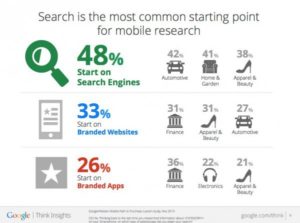What makes a great website work? Is it super design? Is it information capability? Nope, none of these. What makes a website great is the ability to involve the viewer. To involve the viewer so much that they forget they’re even on a website as such and just feel that they’re on a service.
And how do you involve the viewer? By giving them something to DO. Something to BUY most likely, but not only that. They have to get involved and actually DO something while on the site. Result: a great website.
How do you make your website an involving place to visit? By having things for the viewer to do. Then if the site works correctly, the viewer leaves with something done, a transaction.
Information tends to be overrated anyway. We really desire an experience. That is more fulfilling by far.

this graph says 90% of time spent on mobiles is on apps and only 10% on web content.
” …the latest data from Yahoo’s Flurry analytics shows that 90% of a viewer’s mobile time is spent in apps. As they put it: It’s an App World. The Web Just Lives in It. This is a key insight as companies decide whether to develop mobile apps or create mobile device specific apps.
This 90% figure is a key insight as companies decide whether to develop mobile apps or restrict themselves to mobile optimized sites. You do have to be careful about interpreting this since, as the chart below shows, (social sites), messaging, games and utility apps will naturally have the greatest time spent and browser use is still significant by volume if not proportion.” link

Here’s the conventional wisdom:
“The first step towards building up your personal brand is that you need to be as visible as possible online:
- Create a blog or a website where people can learn more about you
- Join social profiles and be active
- Join online communities and social groups where you interact with others
You don’t necessarily need to be on every major social network and start a blog. Rather, keep to what you know realistically you have the time to manage properly and stick with it.”
Spock sure found out what was there, eh?
So maybe first thing is to involve the viewer and build a relationship based on usage and filling a need, a desire. You have to have a new compelling “thing” that the viewer can’t find anywhere else. Then the viewer has to engage with you to have that unique thing. HA. Easy to say, right?
Common sense says I can’t possibly be taking time to “manage my social network” while at the same time uncovering unique gems that the viewer wants (content plus experiences). I have to choose 1 or the other.
Quote:
80% of internet users own a smartphone. (Smart Insights)
Apps account for 89% of mobile media time, with the other 11% spent on websites. (Smart Insights)
Viewers might prefer to do research elsewhere, but they want to enjoy the media through an app. Provide a great experience for your persona in your app and handle your marketing on the web.
91% of mobile users say that access to content is very important. (Wolfgang Jaegel)
Your mobile site should make it as easy as possible for your persona to access your content.
Average smartphone conversion rates are up 64% compared to the average desktop conversion rates. (CMS Report)
So — give extra attention to the mobile experience of your website. If your “experience” gets higher conversions from desktop consider 4 Tipz –> for increasing conversions on your mobile site.
88% of consumers who search for a type of local business on a mobile device call or go to that business within 24 hours. (Nectafy)
1st impressions really do count – folks, elves, and hobbits use their mobile device to find a local business when they’re ready to buy and a great mobile website makes the decision even easier for them. link
Mobile Offers are Redeemed 10x More Frequently Than Print Offers (eMarketer)
Also:
With mobile devices … there’s often an event that puts an abrupt end to the session. The friend arrives, the airplane starts boarding or the light turns green, or the person nearby makes a deal offer on valuable property. In every instance, the session comes to an immediate end.
Winning on mobile is much more than just being there. Quick pathways to conversion are imperative because if you don’t close the sale quickly, the lead is lost – maybe forever. When you plan out a mobile experience, think about whether a user can locate an item and convert on it before that red light turns green. This goes against the conventional wisdom of not asking for a sale too quickly, but mobile users are seeking a streamlined “get in and get out” experience. Making the path to conversion too cumbersome is the biggest risk to lost sales on mobile.
Payment Partners Are Mandatory…. E-commerce giants like Amazon.com can get along using apps that store customer payment information and enable single-click buying, but that only works for mega-sites where millions of customers have accounts.
The great majority of e-commerce sites don’t enjoy that luxury, but they can provide the same ease of checkout by partnering with third-party payment platforms like Paypal, Apple Pay and others.
When they’re enabled, all consumers have to do is log into them and their payment and shipping information is automatically populated. The difference between entering a login and password vs. name, address and credit card information is monumental when it comes to completing or abandoning a purchase. link
Also:
… retailers across the board will get on the mobile payments train by adopting whichever type works best for them, such as mobile POS systems, custom mobile payment apps (like Kohl’s Pay), and third-party options like Apple Pay.
robaireg@gmail.com
